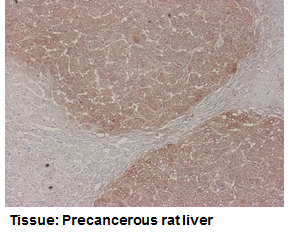Anti-GST-pi (Human) pAb
| Code | Size | Price |
|---|
| MBL-312 | 100 ul | £296.00 |
Quantity:
Prices exclude any Taxes / VAT
Overview
Host Type: Rabbit
Antibody Isotype: IgG
Antibody Clonality: Polyclonal
Regulatory Status: RUO
Target Species: Human
Applications:
- Immunohistochemistry (IHC)
- Western Blot (WB)
Shipping:
4°C
Storage:
-20°C
Images
Documents
Further Information
Alternative Names:
GSTP1 glutathione S-transferase pi 1, PI DFN7 GST3 GSTP FAEES3
Applications:
WB - 1:500-1:1000 (chemiluminescence detection system) IHC - 1:500-1:1000 (frozen sections, paraffin sections)
Background:
GST-Π is a 26kDa protein that
belongs to the GST superfamily of enzymes which have an
important role in detoxification. They catalyze the
conjugation of many hydrophobic and electrophophilic
compounds with reduced glutathione. There are four main
classes: α, u, Π and ?. Results indicate that GST- Π is the
most accurate marker enzyme for detection of initiated
cells during liver carcinogenesis, preneoplasia, colonic
carcinoma and lung carcinoma.
Formulation:
In PBS/50% glycerol, pH 7.2
Gene IDs:
Human: 2950
Immunogen Translated:
Purified human glutatione S-transferase pi
Reactivity:
This antibody reacts with GST- Π, and doesn?t react with other isozymes on Western blotting.
Shelf Life:
1 year
Source:
This antibody was purified from rabbit serum
using protein A agarose. The rabbit was immunized with
purified human glutathione S-transferase Π.
Target:
GST-pi
References
1) Boku, N., et al., Jpn. J. Clin. Oncol. 37, 275-281 (2007)
2) Gu, M., et al., Cancer Res. 67, 3483-3491 (2007)
3) Nagashima, F., et al., Jpn. J. Clin. Oncol. 35, 714-719
(2005)
4) Tsuchida, S., et al., Cancer Res. 49, 5225-5229 (1989)
5) Sato, K., et al., Adv. Cancer Res. 52, 205-255 (1989)
6) Eimoto, H., et al., Carcinogenesis 9, 2325-2327 (1988)
7) Shiratori, Y., et al., Cancer Res. 47, 6806-6809 (1987)
8) Batist, G., et al., J. Biol. Chem. 261, 15544-15549
(1986)
9) Soma, Y., et al., Biochim. Biophys. Acta. 869, 247-258
(1986)
This antibody is used in the reference number 1)-3).






